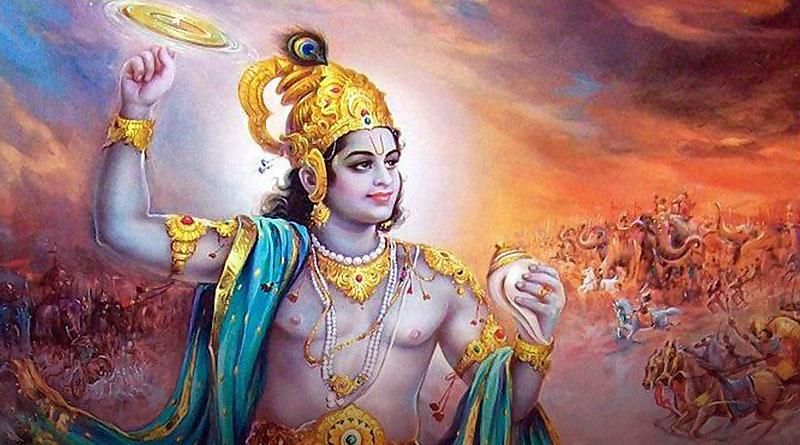Chapter 10 – Vibhuti Yoga (Yoga of Divine Glory)
Summary:
The first half of The Gita: A retrospect –
Friends, we have come halfway through the Gita. It will be worthwhile to recapitulate before we proceed further. In the First Chapter, it is stated that the Gita is for overcoming delusions and inducing us to follow swadharma. In the Second Chapter, the basic principles of life are stated and the concepts of karma yoga and sthitaprajna are spelt out. Chapters 3, 4 and 5 explain the concepts of karma, vikarma and akarma. Karma means the actions done for the performance of swadharma. Vikarma means inner mental action that needs to be done to aid such performance. When karma and vikarma fuse together, the mind is completely purified, passions and cravings die out, distinctions vanish, and then the state of akarma is reached.
The state of akarma attains fruition in two ways. Although these two ways appear different, they are completely identical. These ways are called karmayoga and sannyasa respectively. Although they are known by different terms, they are the same in essence. The state of akarma is the ultimate goal, which is also called moksha. Thus, in the first five Chapters of the Gita, the philosophy of life has been fully spelt out.
The Sixth Chapter tells about the yoga of meditation to have one-pointedness of mind and about the supplementary means of abhyasa and vairagya. The Seventh Chapter is about the great and noble means of bhakti.
The Eighth Chapter puts forward Akshar Brahma Yoga. Vinobaji has named this chapter as satatya yoga (the yoga of uninterrupted pursuit). Satatya Yoga means continuing the sadhana—the spiritual quest—till death.
After explaining this satatyayoga, the Lord tells in the Ninth Chapter something very simple, yet capable of transforming life totally. That is Raja Yoga. Whatever actions ( good and bad) you take from time to time,dedicate them to God,says Raj Yoga.That is why Raja Yoga is also called Samarpan Yoga(Yoga of Dedication).This Raj Yoga or Samapan yoga is nothing but a sweet combination of Karma Yoga and Bhakti yoga.
We shall see in the Tenth Chapter how to master the yoga of dedication to the Lord, how to make it easy to practise.
An easy way to learn to see God–
The methods that we employ in teaching the children have been suggested in this Chapter to enable us to see the Lord everywhere. The children are taught the alphabet in two ways. One method is to teach the letters first by writing them in big size. When the children are conversant with them, they are acquainted with the letters in smaller sizes. The other method is to teach simple letters first and the complicated ‘joint’ letters thereafter.(In Nagari script, alphabets are joined to form joint alphabets. Their form often changes in the process. Therefore, they are more difficult to learn.)
In the same way,we should first learn to see God in His greater Divine manifestations. The Lord manifest in oceans or high mountains can be grasped at once. When we come to experience His presence therein, we shall realize subsequently that He is present even in a drop of water or a speck of dust. There is no difference between the capital ‘A’ and the small ‘a’. This is one way. The other way is to see Him first in His simpler manifestations, and then move on to His complicated manifestations. One can quickly comprehend His Divine manifestation. For example, one can easily discern God in Rama. Rama is like a simple letter. But what about Ravana? Ravana is like a ‘joint’ letter. In Ravana, His manifestation is difficult to discern because there is a mixture of good and evil in the person of Ravana. Ravana’s penance and energy are indeed great, but they are mixed with cruelty.
One should first learn to discern God in a good person, but ultimately one should be able to discern Him in an evil person too. The Lord who is in an ocean is present in a drop of water too. The Lord who is in Rama is present in Ravana too. What is present in the gross is present in the subtle; what is present in the simple is present in the complex. Our vision should be informed with this outlook while reading the book of this world.
God in human form–
We should start with seeing God in the conspicuous forms of the mother, the father, the teacher and the saints, in this order. Then see God in children.
God in creation–
Look at the divine glow that precedes sunrise on the horizon at the dawn.Vedic sages looked upon it as a goddess and danced in ecstasy while singing her hymns.
Likewise, look at the sun. To see him is to see the Lord. He keeps on painting an endless variety of pictures on the canvas of the sky.The sun is indeed the support of life. See God in him.The sun, the rivers, the majestic roaring ocean, all these are forms of the Lord.
And the winds! When they come and where they go, nobody knows. They are the messengers of the Lord.The winds are bringing the Lord’s loving messages every moment. Listen to them.
Look at the fire, with whose worship the Veda begins. Let us see vairagya in fire.
God in the animals–
Our cattle, Cows,bullocks and horses ! We see God in all these animals.Tigers,Lions and Monkeys in the forest; don’t we see God in Them?And those birds peacock, cuckoo and crow;they are also another form of God.
Seeing God in the evil too –
To sum up, God is everywhere in the universe.We must learn to see Him. God in Rama is readily acceptable, but we must also comprehend divinity in Ravana.The Veda has said,”Salutation to the robber chieftain, salutations to the cruel and the violent. The robbers, the cruel, the swindlers, all are Brahman. Salutations to them all.”

